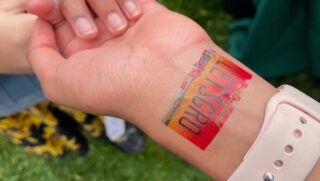Since the 1930s, the American government has developed and supported programs to provide access to nutritional food for the impoverished and other struggling residents.
Originally known as The Food Stamp Program, many changes and reforms throughout the years have shifted the focuses and goals of the program. Today, the program is known as the Supplemental Nutrition Assistance Program (SNAP) and aims to alleviate hunger and malnutrition by increasing food purchasing power for eligible households that apply for participation.
Over 40 million Americans today use SNAP benefits, mainly at large grocery stores like Target and Walmart, but an underutilized sector of where these Americans can use these benefits is at farmers markets.
Until the early 2000s, Americans using SNAP could claim benefits at farmers markets. However, when the government transitioned SNAP to Electronic Benefit Transfer (EBT) cards, farmers markets were left off the list of viable vendors who could accept these cards.
As a result, many SNAP/EBT users were unable to shop at farmers markets, which hurt both customers and farmers.

The national Farmers Market Coalition (FMC), a nonprofit established in the early 2000s, is seeking to remedy this problem. FMC’s mission is driven by three complementary goals, one of which is to provide a market where “… consumers gain access to fresh, nutritious, local produce.”
To ensure that all consumers gain access, FMC provides a SNAP/EBT guide, guiding farmers markets through the complex process of becoming an authorized retailer, from finding funding support to how to implement SNAP/EBT acceptance at the market.
Rachael Ward, a project manager for FMC, is working on initiatives to expand the organization’s outreach efforts. Ward has a Master of Public Health degree in Global Health, and has over 10 years of experience working with farmers markets and community centers to develop food security initiatives.
“I’ve always just been interested in bridging that gap between hunger and food assistance and local food and agriculture … how [can I] help folks access locally grown produce while supporting local farmers?” says Ward.
Ward’s main work centers on the Gus Schumacher Nutrition Incentive Program (GusNIP), which aims to increase the purchase of fruits and vegetables for SNAP/EBT users. Since farmers markets are an excellent source of fresh produce, promoting SNAP/EBT usage at farmers markets is a key way to reach this aim.
To this end, Ward works to help farmers markets establish a nutrition incentive program under GusNIP, allowing farmers to earn the full value of their produce while supporting customers who struggle to acquire fresh fruits and vegetables.

A nutrition incentive program at a farmers market typically works by allowing a customer to claim a dollar value from their EBT card while receiving additional incentive currency, which can be used to purchase fruits and vegetables. Vendors who accept the incentive currency can redeem the currency through the farmers market, and the market in turn is reimbursed by the funding agency.
One market that has implemented such a program is Market Square Farmers’ Market in Knoxville, Tennessee. Housed in the city’s downtown, the market is one of the closest available markets for a community of mixed income households.
“We felt that farmers have been cut out since SNAP went digital,” said Charlotte Tolley, CEO of Nourish Knoxville, which operates the Market Square and other farmers markets in the area.
“[Actually], when we first started accepting SNAP, we found that some of our vendors were the first customers to use SNAP at the market to buy products,” said Tolley.
In addition to being users, “some farmers earn 30 to 40 percent of their revenue from SNAP/EBT users. … Anything that is eligible at a grocery store for EBT qualifies at a farmers market as well,” says Ward.

While it’s no surprise that a farmer’s profit margins are narrow, Tolley said she wasn’t anticipating this dual benefit for farmers when implementing SNAP/EBT at their market.
After first accepting SNAP/EBT benefits in 2009, Tolley said that what really made the program beneficial and work for the market was the SNAP doubling program Double Up Food Bucks, implemented in 2018, which allowed customers to double their spending power at farmers markets.
This nutrition incentive program drew more customers to the farmers market, making the entire effort of accepting SNAP/EBT more profitable and worth the additional work.
“A lot of markets see it as worth it to go through those hoops to provide access to people who need it … but lots of markets just don’t have the capacity,” says Ward, who cites that many markets she has worked with are all volunteer-led and don’t have the backing of a nonprofit or other organization behind them.
Her work with FMC to connect farmers markets to the GusNIP program is critical in helping markets gain the financial assistance they need to support their low- and no-income customers who use SNAP/EBT benefits.
For many farmers who are struggling with narrowing profit margins, the direct-to-consumer approach of farmers markets can be an appealing way to ensure their livelihood.
Shopping at a farmers market also strengthens community bonds, another initiative that FMC focuses on.
“There’s a lot of stigma around who uses SNAP benefits, and what kind of customers that would bring to a farmers market,” says Ward. But ultimately, “we have a duty to set an example for the values we want farmers markets to hold.”
In addition to the work on the GusNIP program, FMC is advocating to diversify and strengthen farmers markets across the nation. FMC has resources to help markets accept WIC (Women, Infants, and Children) for low-income pregnant mothers, infants, and young children to access fresh and healthy foods.
The coalition is involved in the America’s Farmers Market Celebration™, an annual celebration of farmers markets run by American Farmland Trust. AFT and FMC partner to increase awareness of farmers markets as a healthy, viable option for all community members. FMC also provides resources around the Senior Farmers Market Nutrition Program, which supplies low-income seniors with coupons to use at their local farmers market to purchase a variety of goods, such as fruits, vegetables, honey, and herbs.
By advocating for SNAP/EBT acceptance at farmers markets, more Americans can gain access to fresh and healthy foods, foster a sense of community, and support their farmers’ operations.
This article was published by AGDAILY on behalf of American Farmland Trust.
Liza Thuy Nguyen serves as the 2023 American Farmland Trust Agriculture Communications Intern at AGDAILY, with a focus on helping to amplify diversity and minority voices in agriculture. Liza is originally from Anaheim, California, and attended the University of California, Davis, as a first-generation college student. She received a bachelor’s degree in genetics and genomics and went on to earn a master’s in horticulture from Penn State.





